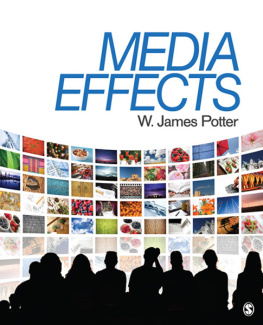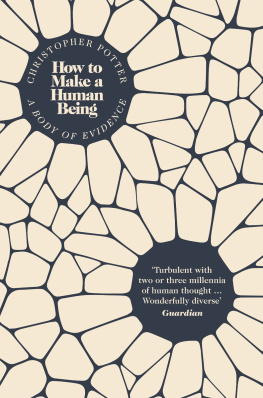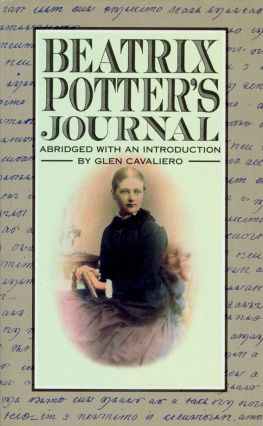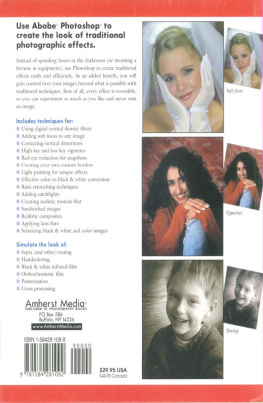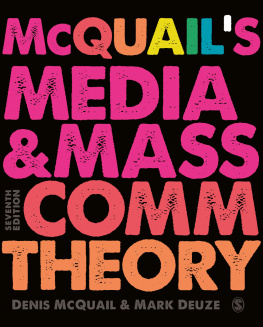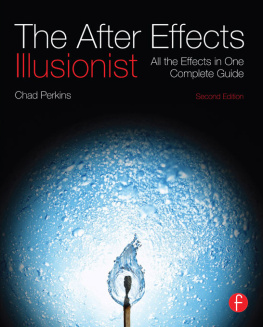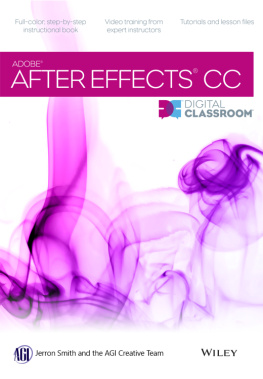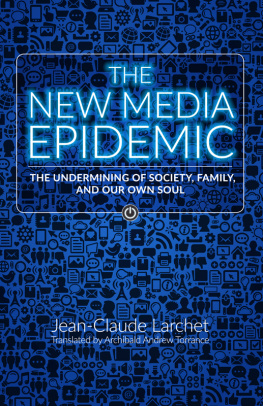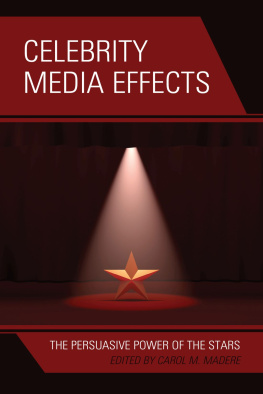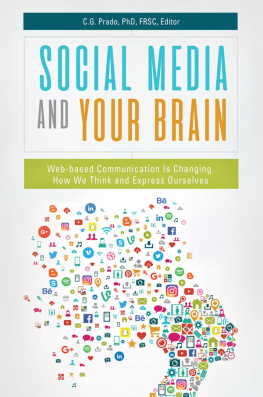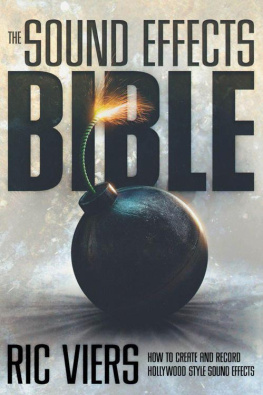FOR INFORMATION:
SAGE Publications, Inc.
2455 Teller Road
Thousand Oaks, California 91320
E-mail: order@sagepub.com
SAGE Publications Ltd.
1 Oliver's Yard
55 City Road
London EC1Y 1SP
United Kingdom
SAGE Publications India Pvt. Ltd.
B 1/I 1 Mohan Cooperative Industrial Area
Mathura Road, New Delhi 110 044
India
SAGE Publications Asia-Pacific Pte. Ltd.
33 Pekin Street #02-01
Far East Square
Singapore 048763
Copyright 2012 by SAGE Publications, Inc.
All rights reserved. No part of this book may be reproduced or utilized in any form or by any means, electronic or mechanical, including photocopying, recording, or by any information storage and retrieval system, without permission in writing from the publisher.
Printed in the United States of America
Library of Congress Cataloging-in-Publication Data
Potter, W. James.
Media effects / W. James Potter.
p. cm.
Includes bibliographical references and index.
ISBN 978-1-4129-6469-2 (pbk.: acid-free paper)
1. Mass mediaInfluence. 2. Mass mediaSocial aspects.
3. Mass mediaPhysiological aspects.
4. Mass mediaPsychological aspects.
I. Title.
P94.P68 2013 302.23dc232011030164
This book is printed on acid-free paper.
12 13 14 15 16 10 9 8 7 6 5 4 3 2 1
Acquisitions Editor: Matthew Byrnie
Editorial Assistant: Elizabeth Borders
Production Editor: Astrid Virding
Copy Editor: Pam Suwinsky
Typesetter: C&M Digitals (P) Ltd.
Proofreader: Dennis W. Webb
Indexer: Ellen Slavitz
Cover Designer: Bryan Fishman
Marketing Manager: Liz Thornton
Permissions Editor: Karen Ehrmann
Preface
Media effects is a very popular topic of discussion. People like to speculate about how society is being harmed by certain kinds of media messages, such as violence, sexual portrayals, bad language, negative stereotypes, superficial news, manipulative advertising, depictions of unhealthy behaviors, and the list goes on. Fortunately, scholars have produced a very large research literature that reveals that the media do, in fact, exert all kinds of influences on us. Some of that influence has been found to be relatively weak, while other influences have been found to be much stronger. Some of that influence occurs infrequently, but other influences are exerted continually in our everyday lives. Some of that influence comes at us directly as we encounter particular media messages, while other influences have been found to come at us indirectly through our institutions and society.
This research literature has great utility in informing our speculations about media effects; that is, we can use the literature to help guide our discussions away from areas where criticism is faulty. However, few people really understand the important patterns of findings in this literature; therefore many discussions about media effects are based on unfounded beliefs rather than on solid knowledge.
Why do so few people understand the nature of media effects? The answer is that this research literature is so large and complex that it is a very challenging task to read through it all without getting lost in the complicated details. Whenever I journey into this countrythat is, read through the media effects literatureI often get lost. I wonder how a particular research study or even a line of research fits into the overall literature. It is rather like several people are showing me pictures of their vacations in a foreign country in random order and I wonder how all those places are related to one another. I often feel frustrated that I am not able to absorb the meaning of the different studies in a way that would help me see the big picture. And I think that this journey would be so much more rewarding and efficient if I had a map.
Where can we find such a map that shows the big picture of media effects? I have been looking for one for decades and have become convinced that one does not yet exist. Of course, there are maps of various neighborhoods; that is, there are scholars who have written very useful books and review articles on particular subtopics, such as the effects of exposure to violence, sexual portrayals, television news, and stereotypes, to name just a few. And there are scholars who have written books on multiple topics about media effects, but those books always leave me with questions such as Are there other issues that we should be concerned about that are not on this author's agenda? and What have those writers overlooked? In short, I wondered about the full set of media effects.
I suspect that you feel the same way; that is, as you read through even a few studies in this very large literature, you can feel disoriented. Like me, you want a map that would provide the full picture of media effects. Such a map would provide a clear structure to help you navigate through this territory efficiently and provide you with a set of categories to help organize your learning.
This book provides such a big picture map of media effects. It took me more than two decades to develop such a map. During that time, I have been taking notes, making outlines, and drawing graphics to help me and my students better understanding various parts of the media effects phenomenon. Eventually all this thinking coalesced into two Media Effects Templatesone for media influences on individuals and the other to organize media influences on macro units, such as the public, institutions, and society. These are the maps that organize the media effects literature and structure this book.
My hope is that you, the readers of this book, will find my overall approach and organizational tools as helpful to you as these have been to me and my students over the years. Of course, I realize that careful readers of this text will undoubtedly find places where my organizational scheme has limits to its utility. I do not claim this is a perfect organization of such a large literature created by so many different kinds of scholars using so many different ideas defined in many different ways. However, I do believe that it is complete in presenting the big picture. To illustrate what I mean by this claim, I return to a geographical analogy. In order to produce a good map of the United States, we need to create a visual that shows all 50 states and illustrates their locations relative to one another. Such a map, however, is limited in how much detail it can provide; it cannot show the dimensions of Aunt Martha's backyard in Des Moines and at the same time keep the viewer's attention on the overall structure of the United States. This book attempts to keep the focus on the big picture, and therefore details are sacrificed at times. Not every study in this large literature is acknowledged, and when I do describe a research study, I foreground the findings and necessarily ignore many of the details that would help you understand how those findings were generated. If you're looking for more details, you'll find many citations of research studies provided in exhibits. The citations refer you to individual research studies that can be easily accessed through your university's library with an electronic search of scholarly journals.
In trying to keep the focus on the big picture of media effects, the book treats the characteristics of history, methods, and theory as background. While these characteristics are important, they are not foregrounded in this book. I am assuming that most readers of this book have not lived with the phenomenon long enough to care much about how thinking and research has changed over time. Also, I am not assuming that readers are experts in research methods, so I do not require you to make fine discriminations among which study's findings are more valid based on an explication of researchers' skill with methods. And I realize that many readers may regard theory as being too abstract, so I try to foreground the practical utility of the predictions the theories make rather than the technical terms used by the theoreticians. By foregrounding

